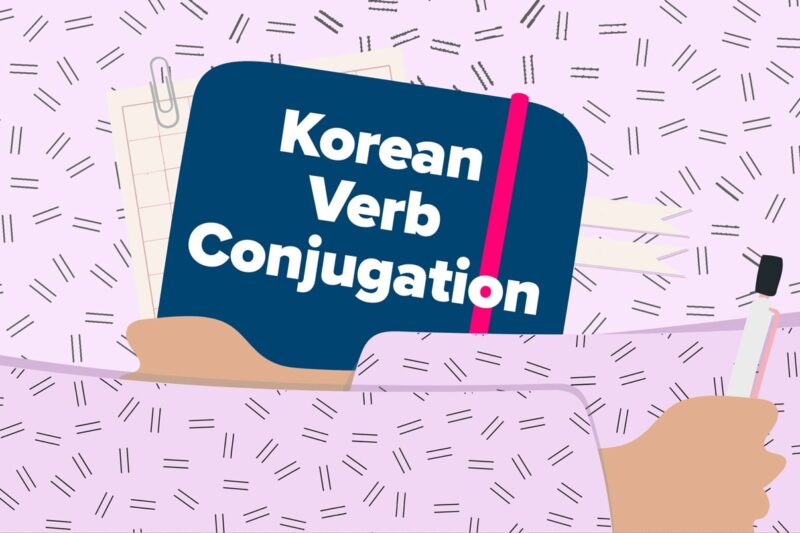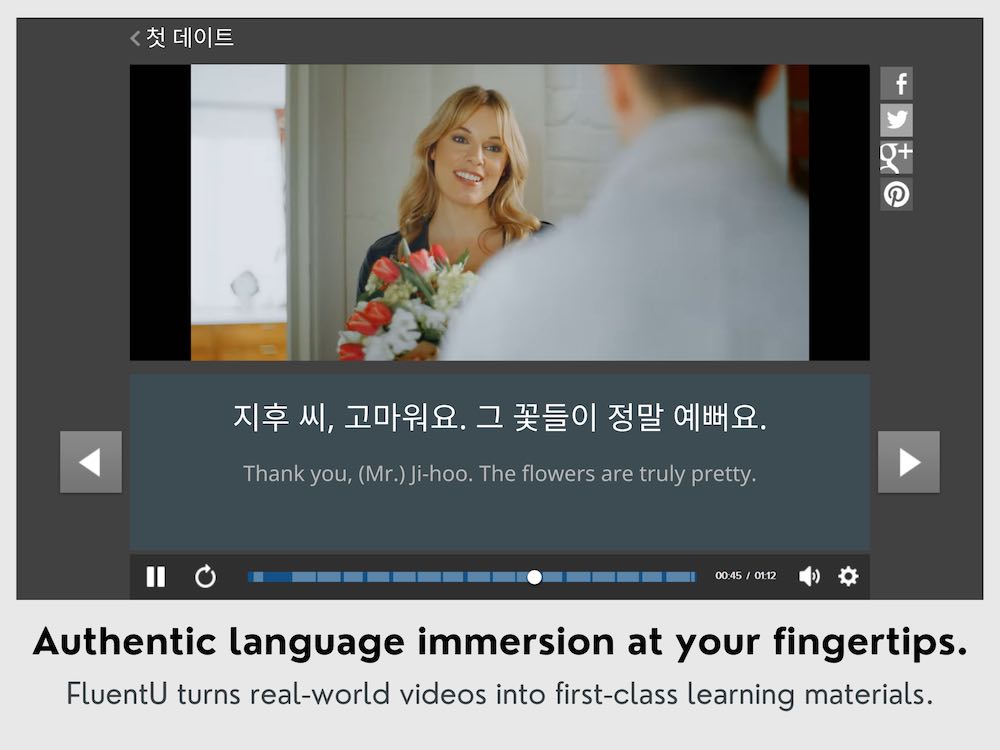
Korean Verb Conjugation
Conjugating verbs in Korean is much easier than in many other languages.
Unlike the Romance languages, in Korean, you don’t have to consider the sentence’s subject when conjugating verbs. The verb stays the same.
Infinitive verbs are also straightforward. In English, we say “to + verb.” In Korean, infinitives simply end in 다. Such as 먹다 — to eat.
So to conjugate a Korean verb, the first step is to separate the verb stem from the 다 ending.
In this post, you’ll learn everything you need to know about Korean verb conjugation—including the three levels of formality and the four tenses.
Contents
- Korean Formalities and Verb Conjugation
- How to Conjugate Present Tense Korean Verbs
- How to Conjugate Present Continuous Tense Korean Verbs
- How to Conjugate Past Tense Korean Verbs
- How to Conjugate Future Tense Korean Verbs
- And One More Thing...
Download: This blog post is available as a convenient and portable PDF that you can take anywhere. Click here to get a copy. (Download)
Korean Formalities and Verb Conjugation
Instead of being conjugated according to pronouns (I, you, we, etc.), Korean verbs are conjugated based on formality level.
There are three main levels of formalities in Korean:
- Casual formality (for people younger than you and close friends)
- Polite low formality (for most everyday situations and with people you’re unacquainted with)
- Polite high formality (for public service announcements and when talking to people with a higher social status than you)
Next, there are the four verb tenses:
- Present tense
- Present continuous tense
- Past tense
- Future tense
Most Korean verbs are regular—meaning the verb stem stays the same when conjugated. But there are a few irregular verbs where the stem changes.
Since this is a beginner’s guide, we’ll focus primarily on verbs without irregularities in their conjugation.
If you ever encounter a verb you don’t know how to conjugate, you can always use the Verbix conjugation tool.
You can also see how conjugations are used in real Korean conversations on FluentU. FluentU takes authentic videos—like music videos, movie trailers, news and inspiring talks—and turns them into personalized language learning lessons. You can try FluentU for free for 2 weeks. Check out the website or download the iOS app or Android app. P.S. Click here to take advantage of our current sale! (Expires at the end of this month.)
How to Conjugate Present Tense Korean Verbs
Conjugating verbs in the present tense in Korean is easy.
All you have to do is drop the 다 ending on the verb stem and add the verb ending that goes with the formality you want to use:
| Formality | Conjugation |
|---|---|
| Casual formality | Verb + 아 or 어 |
| Polite low formality | Verb + 아요 or 어요 |
| Polite high formality | Verb + 습니다 (if the verb ends in a consonant) Verb + ㅂ니다 (if the verb ends in a vowel) |
Whether you use 아 or 어in the casual form or 아요 or 어요 in the polite form depends on the last vowel.
- Last vowel in the verb is ㅏor ㅗ = 아요
볶다 (to fry) → 볶아요
- Last vowel in the verb is anything else = 어요
먹다 (to eat) → 먹어요
아 or 어 will combine with the previous syllable if the verb stem ends in a vowel.
- ㅏ + 아 = ㅏ
가다 (to go) → 가요
- ㅗ + 아 = ㅘ
보다 (to see) → 봐요
- ㅓ + 어 = ㅓ
서다 (to stand) → 서요
- ㅣ + 어 = ㅕ
달리다 (to run) → 달려요
- ㅜ + 어 = 워
배우다 (to learn) → 배워요
Let’s take a look at how three common Korean verbs are conjugated in the present tense according to each formality:
| Formality | 하다 — to do | 가다 — to go | 달리다 — to run |
|---|---|---|---|
| Casual formality | 해 | 가 | 달려 |
| Polite low formality | 해요 | 가요 | 달려요 |
| Polite high formality | 합니다 | 갑니다 | 달립니다 |
Note that 하다 conjugates a little differently than other verbs. Rather than becoming 하요 as you’d expect from the rules above, it becomes 해/해요.
How to Conjugate Present Continuous Tense Korean Verbs
The present continuous tense is used for actions that are currently ongoing. This tense is formed in English by using “am/is/are” and adding “-ing” to the main verb.
After dropping 다 from the infinitive, add one of these formality endings:
| Formality | Conjugation | 하다 — to do | 가다 — to go | 달리다 — to run |
|---|---|---|---|---|
| Casual formality | Verb + 고 있어 | 하고 있어 | 가고 있어 | 달리고 있어 |
| Polite low formality | Verb + 고 있어요 | 하고 있어요 | 가고 있어요 | 달리고 있어요 |
| Polite high formality | Verb + 고 있습니다 | 하고 있습니다 | 가고 있습니다 | 달리고 있습니다 |
How to Conjugate Past Tense Korean Verbs
Like the present tense, past tense conjugations rely on what vowel the verb stem ends in.
- Ends in ㅗ or ㅏ = add 았다 to the verb stem
- Ends in any other vowel = add 었다
Some vowel endings also combine like the present tense:
가다 + 았어요 → 갔어요
| Formality | Conjugation | 하다 — to do | 가다 — to go | 달리다 — to run |
|---|---|---|---|---|
| Casual formality | Verb + 았어 or 었어 | 했어 | 갔어 | 달렸어 |
| Polite low formality | Verb + 았어요 or 었어요 | 했어요 | 갔어요 | 달렸어요 |
| Polite (high formality) | Verb + 았습니다 or 었습니다 | 헀습니다 | 갔습니다 | 달렸습니다 |
How to Conjugate Future Tense Korean Verbs
There are multiple ways of expressing the future tense, but we’ll just look at the most common conjugation in this article.
After dropping 다 from the verb, add ㄹ (for verbs ending in vowels) or 을 (for verbs ending in consonants).
It’s also worth noting that you don’t need to add anything to verbs ending in ㄹ.
| Formality | Conjugation | 하다 — to do | 가다 — to go | 달리다 — to run |
|---|---|---|---|---|
| Casual formality | Verb + ㄹ or 을 거야 | 할 거야 | 갈 거야 | 달릴 거야 |
| Polite low formality | Verb + ㄹ or 을 거예요 | 할 거예요 | 갈 거예요 | 달릴 거예요 |
| Polite high formality | Verb + ㄹ or 을 겁니다 | 할 겁니다 | 갈 겁니다 | 달릴 겁니다 |
And there you have it—the complete, beginner-friendly rundown on Korean verb conjugation.
If you study and practice regularly, you’ll become a Korean verb conjugation machine in no time!
Download: This blog post is available as a convenient and portable PDF that you can take anywhere. Click here to get a copy. (Download)
If you enjoyed this post, you're already halfway to having the time of your life learning Korean with FluentU!
FluentU makes it possible to learn with K-pop videos, funny commercials, entertaining web series and more. Just a quick look will give you an idea of the variety of FluentU videos on offer:
FluentU really takes the grunt work out of learning languages, leaving you with nothing but engaging, effective and efficient learning. It's already hand-picked the best videos for you (which are organized by level and topic), so all you have to do is simply choose any video that strikes your fancy to get started.
Each word in the interactive captions comes with a definition, audio, image, example sentences and more.
Access a complete interactive transcript of every video under the Dialogue tab, and easily review words and phrases from the video under Vocab.
You can use FluentU’s unique Quiz Mode to learn the vocabulary and phrases from the video through fun questions.
FluentU keeps track of what you're learning, and tells you exactly when it's time for review, giving you a 100% personalized experience.
Review sessions use video context to help embed the words in your memory.
Start using the FluentU website on your computer or tablet or, better yet, download the FluentU app from the iTunes or Google Play store. Click here to take advantage of our current sale! (Expires at the end of this month.)
And One More Thing...







